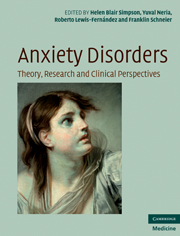Book contents
- Anxiety Disorders
- Dedication
- Anxiety Disorders
- Copyright page
- Contents
- Contributors
- Foreword
- Preface
- 1 Introduction: the need for interdisciplinary approaches
- Section 1 Evolving concepts of anxiety
- Section 2 Challenges in diagnosing pathological anxiety
- 7 Challenges in OCD research: overcoming heterogeneity
- 8 Is there a spectrum of social anxiety disorder?
- 9 Co-occurring anxiety and depression: concepts, significance, and treatment implications
- 10 Understanding health anxiety
- 11 Axis II and anxiety disorders
- 12 “Idioms of distress” (culturally salient indicators of distress) and anxiety disorders
- Section 3 Understanding the causes of anxiety
- Section 4 Treatment of anxiety: current status and controversial issues
- Index
7 - Challenges in OCD research: overcoming heterogeneity
from Section 2 - Challenges in diagnosing pathological anxiety
Published online by Cambridge University Press: 10 November 2010
- Anxiety Disorders
- Dedication
- Anxiety Disorders
- Copyright page
- Contents
- Contributors
- Foreword
- Preface
- 1 Introduction: the need for interdisciplinary approaches
- Section 1 Evolving concepts of anxiety
- Section 2 Challenges in diagnosing pathological anxiety
- 7 Challenges in OCD research: overcoming heterogeneity
- 8 Is there a spectrum of social anxiety disorder?
- 9 Co-occurring anxiety and depression: concepts, significance, and treatment implications
- 10 Understanding health anxiety
- 11 Axis II and anxiety disorders
- 12 “Idioms of distress” (culturally salient indicators of distress) and anxiety disorders
- Section 3 Understanding the causes of anxiety
- Section 4 Treatment of anxiety: current status and controversial issues
- Index
Summary
- Type
- Chapter
- Information
- Anxiety DisordersTheory, Research and Clinical Perspectives, pp. 69 - 79Publisher: Cambridge University PressPrint publication year: 2010

